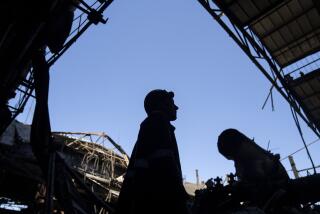Urals Nuclear Disasters Contaminated 450,000 : Russia: Figure is given by officials in account of events at the Mayak atomic plant from 1948 to 1967. They say site could still pose hazards.
- Share via
MOSCOW — Russian officials, disclosing new details about a series of nuclear disasters in the Ural Mountains, have admitted that 450,000 people were contaminated by radiation from the giant Mayak atomic plant between 1948 and 1967, and that the site remains a potential hazard.
The revelations accompanied a $20-million government allocation, sent Friday to the Supreme Soviet, to provide compensation and health services to victims and to improve waste management at the plant near Chelyabinsk, which made weapons-grade plutonium for nuclear warheads.
Vasily Voznyak, head of a government commission on the consequences of nuclear accidents, told reporters this week that some of the plant’s radioactive wastes are still stored in unsafe conditions.
“Of course, not all of this can explode at once tomorrow, but there are still some containers (of the kind) which leaked in 1957, and therefore potentially the danger exists,” he said. “If there were a major accident, the radioactive dumps on the territory of the plant are still capable of producing much more pollution than the 1986 accident at Chernobyl.”
Chernobyl, site of the worst-ever nuclear disaster, in Ukraine, sent radioactive clouds over much of Europe and halted the development of nuclear energy throughout the Soviet Union.
The safety of waste dumps at Mayak is a critical environmental issue in Russia because the government now plans to resume construction of nuclear power plants. Officials at the Atomic Energy Ministry told reporters two weeks ago that Russia’s power plants are as safe as any in the West.
Environmentalists oppose the program, arguing that Russia’s waste storage plans are inadequate and underfinanced.
About half the $20 million allocated this week would rebuild Mayak to enable the plant to reprocess its own wastes, rendering them harmless.
According to Voznyak’s account, the most detailed ever by a Russian official, the Mayak plant damaged the surrounding environment in three stages after its construction in 1948.
For the first seven years, the plant dumped radioactive waste into the local river, poisoning the drinking and irrigation water of 124,000 people, he said.
The most serious radiation, in 1957, resulted from an explosion of nuclear wastes that caused thousands of casualties. Ten years later, Lake Karachai dried up and radioactive wastes dumped there were scattered by the winds over populated areas.
Soviet authorities kept the incidents secret. They were first reported in 1976 by Zhores Medvedev, a dissident scientist, and finally acknowledged by the government more than a decade later, under President Mikhail S. Gorbachev.
More to Read
Sign up for Essential California
The most important California stories and recommendations in your inbox every morning.
You may occasionally receive promotional content from the Los Angeles Times.










